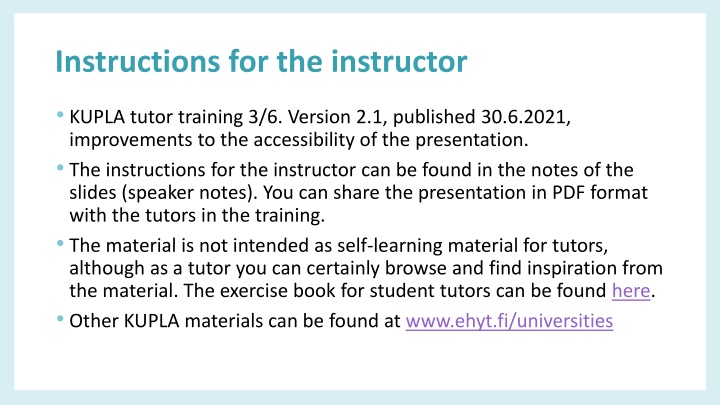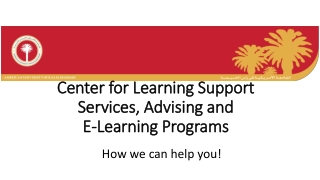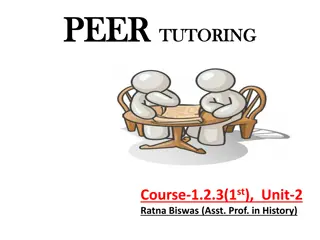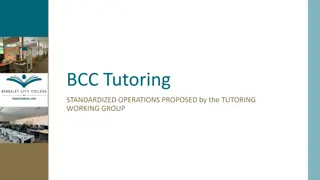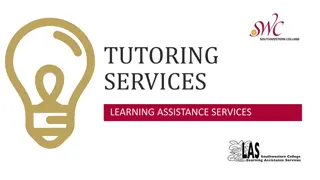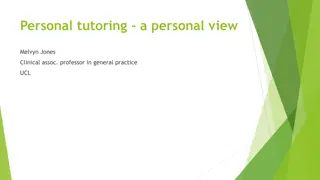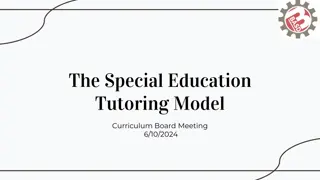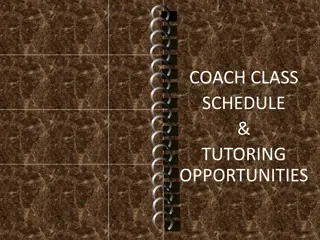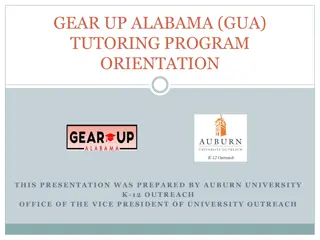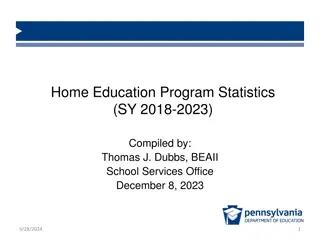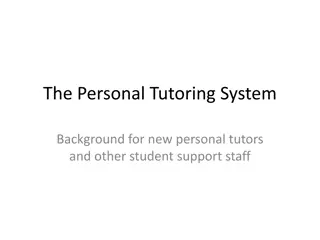Enhancing Group Dynamics and Safe Environments for Effective Tutoring
Learn key stages of group processes and how to foster a safe atmosphere for tutoring. Develop skills to guide groups and plan engaging activities for new participants. Explore the importance of forming, storming, performing stages and creating a supportive group culture. Discover ways to make groups inclusive and beneficial for all participants.
Download Presentation

Please find below an Image/Link to download the presentation.
The content on the website is provided AS IS for your information and personal use only. It may not be sold, licensed, or shared on other websites without obtaining consent from the author.If you encounter any issues during the download, it is possible that the publisher has removed the file from their server.
You are allowed to download the files provided on this website for personal or commercial use, subject to the condition that they are used lawfully. All files are the property of their respective owners.
The content on the website is provided AS IS for your information and personal use only. It may not be sold, licensed, or shared on other websites without obtaining consent from the author.
E N D
Presentation Transcript
Instructions for the instructor KUPLA tutor training 3/6. Version 2.1, published 30.6.2021, improvements to the accessibility of the presentation. The instructions for the instructor can be found in the notes of the slides (speaker notes). You can share the presentation in PDF format with the tutors in the training. The material is not intended as self-learning material for tutors, although as a tutor you can certainly browse and find inspiration from the material. The exercise book for student tutors can be found here. Other KUPLA materials can be found at www.ehyt.fi/universities
TUTOR TRAINING Tutor s group guiding skills and safe atmosphere
Training objectives Understand the different stages of the group process and be able to take them into account while tutoring. Understand the importance of a safe group and know how to create a safe atmosphere in a group. Tutor understands that guiding a group is a skill you can learn. Know how to plan familiarization exercises that are suitable for all freshers.
Training topics Group process Forming stage and safe atmosphere Storming Performing and adjourning
Group process: Forming phase and and creating a safe atmosphere
Exercise The elements of a great group F What type of group suits you best? What types of great groups have you been a member of? Discussion (3 min) What made/would make this group great? What characteristics are associated with a great group?
Exercise A safe group is: Write down the answers the groups give F
Groups at universities Study group, tutoring group, year class, student organisation, hobby group, work group, and so on. 22% of university/UAS students feel that they are not part of any student group, such as their class or a study group (FSHS 2017). 20% of university students and 15% of students in universities of applied sciences find it clearly or extremely difficult to establish social contacts. (FSHS 2017).
Group process Source: Ryhm ilmi , ryhm nohjaajan k sikirja 2015, EHYT ry
During the forming stage of the group What do others think of me? People want to please, get approval, not to stand out from the crowd. Participants act on their own previous group experiences. Joining a group can be difficult if you have a bad group experience in the past. Group members take on a role: the group may be dominated by individuals who are seen and heard, many take on the role of an observer. The group has no common rules. Try to create as safe an atmosphere in the group as possible
Safe atmosphere, how is it created? 1/2 Keep in mind that everyone s personal boundaries are different. Keep in mind that each member has their own pace of becoming a part of the group. Ensure that each member gets the chance to talk about themselves and participate in the discussion to their preferred extent. Carry out the familiarization exercises in pairs and in small groups, varying the group configurations as much as possible to get the members to get to know each other. Getting to know each other does not require touching others.
Safe atmosphere, how is it created? 2/2 Plan the meetings in advance and tell the participants about the content before the meeting. Share your positive experiences, tips, and good practices related to studying. Present the facilities, customs, communities, and digital environments. Talk about the positive elements in your studies and your motivations for your field of study. Share experiences about the reasons why the group members have wanted to study in this particular field. Together, form the group ground rules; ask how the participants want to be part of the group.
From children s games to excercises The target group is adults What kind of exercises would you have a workplace well-being day? Exercises must have purpose Before you begin, tell the participants what you are going do, how, and why. Justification makes it easier to participate. Safe atmosphere vs. discomfort Encourage, don't force. A well-explained and justified exercise and an enthusiastic tutor inspires people to join in. Let them know that it's also ok to just follow the activities. The exercises that work the best for you may not work as well for others.
Exercise Line exercise F Place yourself on the line according to your opinion. You can agree with the statement/question, disagree or place yourself somewhere in between these two. There are no right or wrong answers.
Exercise F I have been able to be myself I haven t been able to be myself in groups
Exercise F I feel uncomfortable in icebreaker exercises I don t feel uncomfortable
Exercise F Getting heavily drunk is part of the student culture not part of the student culture
Exercise What do we have in common? F Objective: getting to know the other members of the group. Find a person you don t already know in the room and start by saying your name Have a discussion and pick three things you have in common. Then, find another pair, form a group of four and find what the four of you have in common. You can also try to find what the entire group has in common.
Exercise Unique F Objective: getting to know the other members of the group. All participants stand in a circle. The first participant says their first name/nickname and then some unique thing about themselves. If there is someone else in the crowd who shares the same thing, they raise their hand. The same person comes up with new unique things as long as hands no longer rise. Once a person has come up with one unique thing about themselves, the next person tries to come up with a unique thing (they may be successful at first try).
Exercise On the map F Objective: getting to know the other members of the group. Imagine that the space where the group has gathered is the map of Finland (or the world). Go through the south, north, west and east. Ask the participants to move on the map according to instructions. After each question, ask the participants to tell the person next to them why they chose that particular spot. If the group is small, you can ask each one individually why they chose this spot on the map so that the whole group can hear the answers. Ask the participants to tell their names before answering. The questions may include where do you live now? where did you live before moving to your current city? where were you born, where did you start comprehensive school...
Exercise Introduce your field of study Objective: Getting to know another student from a different field of study. Tell a tutor from another field about your field of study. For example, you can introduce your field of study by answering the following questions: What has been positive in your studies? What interests/motivates you the most in your field? What important skills have you learned concerning your future profession?
Exercise In the same field F Objective: To strengthen group cohesion by discussing common field and studies. Divide the freshers in pairs or groups of three and instruct them to discuss the following questions: What do you expect from your studies? Why were you interested in this field? What things are you particularly interested in in your future studies? What kind of job(s) do you hope to find employment? You can process the exercise by asking if any pair/group wants to share what they were talking about.
Exercise News round: Plusses and minuses F Objective: getting to know the other members of the group and strengthening the group spirit. In addition, the tutor gets more information about the group. Each in turn says one negative and one positive thing about this week or issue related to starting studies. The positive thing is said last. Everyone gets to say something about themselves. A round of news can be used for each group meeting as a habit; routines increase the sense of safety within the group. Works best in groups of 5 20 people.
Storming phage Group members consider whether other members of the group can be trusted. They seek their own role, the courage to express their own opinions increases. Dominant individuals and small circle clicks are easily formed within a group, some may experience themselves as outsiders. Support the group in dealing with conflicts, group ground rules and their possible updating, use familiarization exercises.
Exercise Case Sassa Think about the following situation in pairs/small groups: New student Sassa says that they do not quite get along with the other members of their fresher/student group. Sassa is upset about the situation as they feel lonely. What do you do as a tutor in this situation?
Regarding loneliness, it is good to distinguish: The desire to study alone. The desire to spend time on campus alone. A person who looks lonely. A person who feels lonely: Emotional loneliness: lack of close relationships, friends, or a partnership. Restlessness, anxiety, hopelessness. Social loneliness: lack of a broader social network, feeling of being an outsider in the community (for example a study group, field of studies). Source: V lim ki ym. Yksin yliopistokaupungissa, Nuorisotutkimus 36 (2018):3
Group process: performing and adjourning
Performing phase Good team spirit, good group ground rules and it feels safe to participate. Also be involved in those good stages of the group. Meetings should be resumed regularly and arranged well in advance.
Adjourning phase Will the group continue to exist when the tutoring ends? Arrange the final meeting in advance. Make sure the group members know where to get guidance after the tutoring ends.
Summary You are guiding a group of adults. Take into account the different backgrounds, experiences and expectations that the members have when starting. Ask how the activities would be the easiest for everyone to participate in and tell them in advance what will be done in the exercises, meetings, and events. Plan well-grounded exercises for getting to know each other. It is good to start with discussion tasks. Do not force or pressure anyone to participate for any reason ( traditions or everyone else does it etc.) Be prepared to change your plans during the activities as well. Remember that all groups are different no matter what the tutor does. Guiding a group is a skill you can learn. Even in challenging situations, you are not alone, help is available.
KUPLA Students reforming substance use culture The training has been developed by KUPLA Students reforming substance use culture , a joint project by EHYT ry and Nyyti ry. The project was ongoing from 2018 to 2020. National partners in the programme included the National Union of University Students in Finland (SYL), University of Applied Sciences Students in Finland (SAMOK), Finnish Student Sports Federation (OLL) and the Finnish Student Health Service (FSHS). This work is licensed under a Creative Commons Attribution 4.0 International License. Read more about the license on Creative Commons website. This training may be used, shared and modified freely with a reference to KUPLA as the original author. Other materials for the KUPLA project can be found on EHYT's website, www.ehyt.fi
